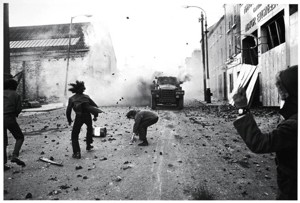Bloody Sunday

(Credit: Photo by Gilles Peress)
Lots of people have been killed on Sundays, and the phrase is used to describe lots of mass killings. Wikipedia shows 20+ events that are connected to the phrase.
The most recent event and the one most clearly associated with the phrase from this generation is a 1972 shooting of protesters in Derry, Northern Ireland by the British Army. In a 45-minute span, British paratroopers shot 29 people, 14 of whom would die (13 immediately; one months later of his wounds).
Two official investigations of the event were conducted. They conflict.
- The initial investigation supported the Army, stating that they fired in self-defense at protesters carrying bombs and weapons.
- Another report issued in 2010 faulted the Army, saying they were reckless and most of the protesters had no weapons. It also noted that a single paratrooper – “Soldier F” – killed five of the victims. Prime Minister David Cameron subsequently issued a public apology for the event.
In 2015, Soldier F was arrested for questioning. In 2019, he was charged. However, the charges were dropped in 2021 when evidence was deemed inadmissible.
Soldier F has since been identified.
Why I Looked It Up
I remember the U2 song “Sunday, Bloody Sunday.” The lyrics go:
I can’t believe the news today
Oh, I can’t close my eyes and make it go away […]Broken bottles under children’s feet
Bodies strewn across the dead end street
But I won’t heed the battle call
It puts my back up
Puts my back up against the wall
My reading of the lyrics strikes me as less a recounting of the specific event, and more just a polemic against The Troubles in general.
Then, in late January 2022, the NY Times published a long feature commentating the 50th anniversary of the event –
50 Years On, Bloody Sunday’s Wounds Are Still Felt
Here’s the lede:
The events themselves took a matter of minutes to unfold in a paroxysm of one-sided gunfire that snuffed out more than a dozen lives, each one of them a new martyr in Northern Ireland’s somber annals of loss. But the effort to unravel what happened in those brief moments – to parse the antecedents and the outcomes, to trace the lines of command on the grisly day that became known as Bloody Sunday – devoured years of costly inquiry.